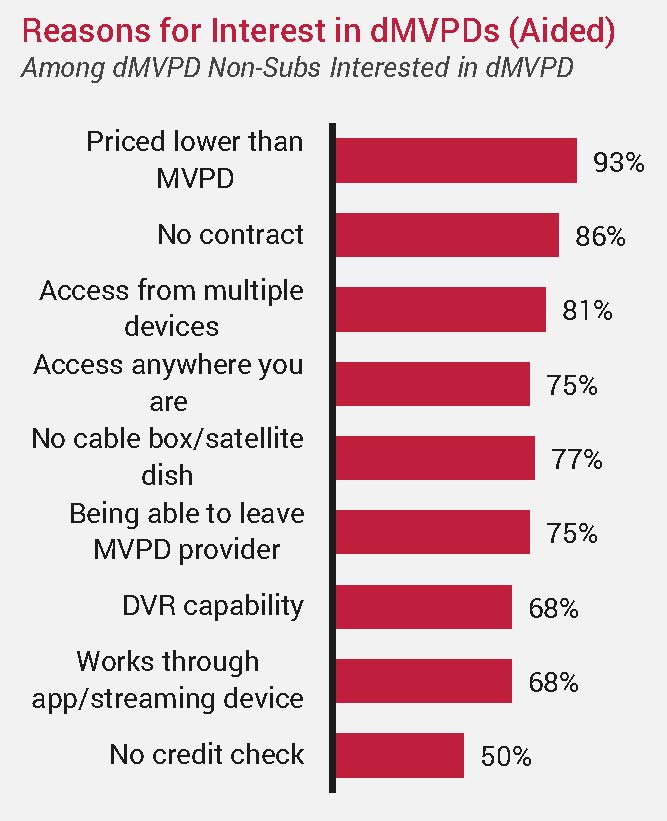Shifting to a Consumer-Centric Paradigm
We face a new competitive media environment in which multichannel video programming distributors must gain a deeper understanding of their customers in such critical areas as:

• Understanding household relationships beyond RGUs.
• Gaining an overview of cord-cutters and over-the-top customers: Who is leaving? Who comes back? How long are they gone?
• The impact of OTT, or customer experience challenges and opportunities.
• Internet positioning: How can distributors leapfrog speed to become the best internet solution?
Addressing such strategic questions requires a paradigm shift. Due to the oligopolistic market structure for managed video, data and voice, the multichannel industry has focused on selling more revenue-generating units (i.e., acquisition), not on retention and loyalty.
Consumers, though, have more choices for entertainment and data services than ever, including the choice to leave managed services providers altogether. At this juncture, the industry must consider adopting a customer-centric mindset to adapt to the new marketplace. Shifting to a consumer-centric point of view is fundamental to approach strategic questions, including:
• How should we think about households as a collection of people with needs and desires distributors can meet?
• Who are the cord-cutters and why are they leaving traditional pay TV?
• Might building different levels of video services potentially cannibalize existing business?
• How do you position internet products to resonate with consumers?
In our view, success for the multichannel industry requires a new mantra:
Retain, Entertain, Relate
The smarter way to stay on top of the multichannel video marketplace. Sign up below.
The first step is to understand subscribers as more than a collection of RGUs. Rather, they are households that you can delight and empower but with budgets and other bills to pay.
For households with multiple TVs, per-box rental fees and associated costs can make a reasonably priced introductory offer prohibitively expensive. Pushing additional services, including forcing customers to subscribe to products they don’t need for a “better deal,” creates a negative dynamic. Here, “personalization” has real meaning as each household should feel like it is getting a sensible offer after an honest needs assessment.
Highly relevant to this question is Horowitz Research’s proprietary segmentation of TV viewers, which identifies three segments: Content Omnivores, Content Paleos, and 5 O’Clock Diners.

Comprising 7% of the TV viewer universe, Content Paleos represent the smallest segment. Less likely to have children at home, they spend less time watching content on any screen, are much less likely to be multichannel subscribers and are largely cord-cutters and cord-nevers whose needs are easily satisfied by self-managed services.
5 O’Clock Diners comprise 32% and watch traditional platforms — live, VOD, DVR. They are the traditional TV counterpart to Content Paleos, focusing on news, broadcast and sports. They skew older and are less likely to have children at home; but are the most likely to subscribe to traditional multichannel TV.
Content Omnivores watch the most TV and have the most varied needs. They have the highest household income of all segments and are likely to have children at home. To keep up with the demand for content, they need managed and self-managed OTT services.
With new digital MVPDs entering the fray, Content Omnivores are the most vulnerable. With larger households, Content Omnivores likely pay the most for TV services. They need to be retained, entertained and engaged.
Being, on average, younger and more tech-savvy, Omnivores are the primary market of all players. While MVPDs may ask whether virtual providers can be as compelling as traditional ones, Content Omnivores have reversed the question: Can a traditional MVPD be as robust, compelling and convenient as a virtual provider? For these consumers, traditional MVPDs must ask how they can continue to be relevant to households as millennial and Generation Z consumers become key decision-makers.
Given the size of the Content Omnivore segment, it is imperative for MVPDs to understand how to retain these customers. Next-generation features, such as cross-platform search and discovery and voice control, deliver great perceived value to multichannel subscribers, especially young consumers.
Centering Around Consumers
In addition to technology advances, consumers express a desire for customer-centric experiences from TV providers, including:
• Flexible payment options (change billing dates or putting accounts on temporary hold);
• Empowering customer service representatives with greater flexibility to negotiate;
• Better communication about when promotional pricing ends;
• Engagement throughout the purchase and retention journey that relates to customer needs;
• Loyalty programs with material rewards.
As an industry, we must begin to think like our customers. The necessary technology exists but the industry’s willingness to adapt has lagged. The multichannel industry’s failure to anticipate consumers’ appetite for on-demand content and new viewing behaviors provided the entrée for Netflix to blaze a trail in this area. While adoption of streaming services has skyrocketed, usage of VOD, DVR and provider apps/sites has not experienced the same growth. It’s time for MVPDs to step up their game to include their customers as collaborators.
Adriana Waterston is senior vice president, insights and strategy at Horowitz Research.
